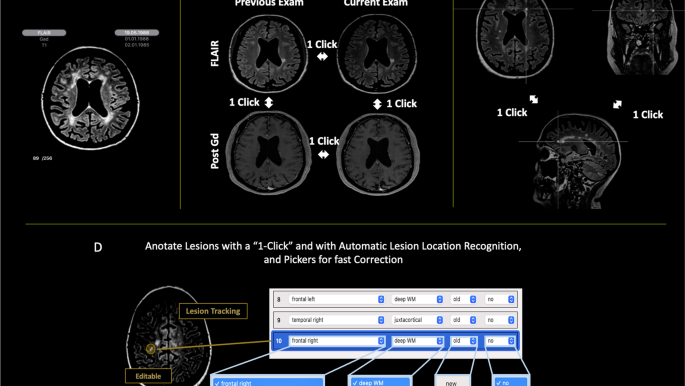
A retrospective multicenter study spanning Switzerland, France, and the USA evaluated Jazz (AI Medical), an AI tool aimed at automating MRI scan analyses for the detection of lesions in multiple sclerosis (MS) patients. Tested on 117 patients, Jazz excelled in identifying lesions, detecting 63 new lesions and 95 slowly expanding lesions (SELs), surpassing standard clinical reports that identified 24 new lesions and reported no SELs. The reading time with AI was on average of 2 min 33 s per case. Despite this, inter-reader agreement showed moderate (kappa = 0.5) for new lesions and slight (0.08) for SELs, indicating Jazz's effectiveness in enhancing lesion detection accuracy and efficiency, while also highlighting the need for improved consistency among radiologists.
Read full study
Evaluation of the quality and the productivity of neuroradiological reading of multiple sclerosis follow-up MRI scans using an intelligent automation software
Neuroradiology, 2024
Abstract
Purpose: The assessment of multiple sclerosis (MS) lesions on follow-up magnetic resonance imaging (MRI) is tedious, time-consuming, and error-prone. Automation of low-level tasks could enhance the radiologist in this work. We evaluate the intelligent automation software Jazz in a blinded three centers study, for the assessment of new, slowly expanding, and contrast-enhancing MS lesions.
Methods: In three separate centers, 117 MS follow-up MRIs were blindly analyzed on fluid attenuated inversion recovery (FLAIR), pre- and post-gadolinium T1-weighted images using Jazz by 2 neuroradiologists in each center. The reading time was recorded. The ground truth was defined in a second reading by side-by-side comparison of both reports from Jazz and the standard clinical report. The number of described new, slowly expanding, and contrast-enhancing lesions described with Jazz was compared to the lesions described in the standard clinical report.
Results: A total of 96 new lesions from 41 patients and 162 slowly expanding lesions (SELs) from 61 patients were described in the ground truth reading. A significantly larger number of new lesions were described using Jazz compared to the standard clinical report (63 versus 24). No SELs were reported in the standard clinical report, while 95 SELs were reported on average using Jazz. A total of 4 new contrast-enhancing lesions were found in all reports. The reading with Jazz was very time efficient, taking on average 2min33s ± 1min0s per case. Overall inter-reader agreement for new lesions between the readers using Jazz was moderate for new lesions (Cohen kappa = 0.5) and slight for SELs (0.08).
Conclusion: The quality and the productivity of neuroradiological reading of MS follow-up MRI scans can be significantly improved using the dedicated software Jazz.
